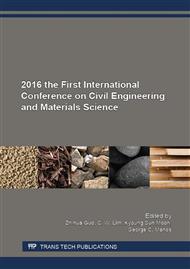p.78
p.83
p.88
p.94
p.99
p.109
p.114
p.119
p.124
Durability of Red Mud Based Geopolymer Paste in Acid Solutions
Abstract:
The present investigation is on the effect of red mud on the mechanical properties and durability of the geopolymer paste in sulphuric and acetic acid solution. Red mud and fly ash were used to form the geopolymer paste along with the alkalies. The variation of red mud in the paste composition was from 0% to 90%. Cylindrical shaped specimens of 1 inch diameter and 1 inch height were prepared. The specimens were immersed in 5% sulphuric acid and 5% acetic acid for 1, 7, 14, 28, 56 and 84 days and tested for weight loss, visual deformation, strength loss and colour of the solvent, based on the procedure specified by ASTM C 267 – 01. SEM/EDX Tests were performed on the geopolymer specimens. Test results show that initially, the strength of the geopolymer increased upon the addition of red mud. The strength was maximum when the percentage of red mud was 30%. The maximum strength obtained was 38 MPa for the paste containing 30% red mud using 10M alkali solution as against 31.69 MPa, when only fly ash was used. Geopolymer paste containing 30% and 50% red mud showed better resistance to acid attack. The strength loss was minimum for the samples containing 30% red mud in both inorganic and organic acid i.e. sulphuric and acetic acid.
Info:
Periodical:
Pages:
99-105
Citation:
Online since:
August 2016
Authors:
Keywords:
Price:
Сopyright:
© 2016 Trans Tech Publications Ltd. All Rights Reserved
Share:
Citation:


